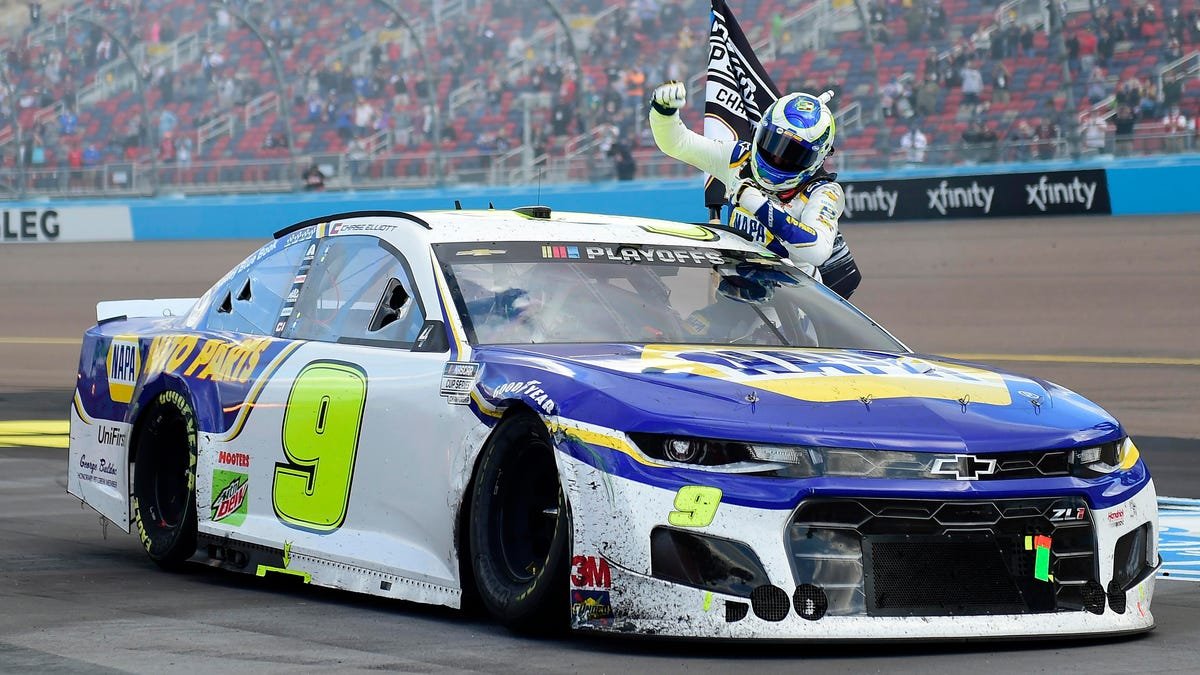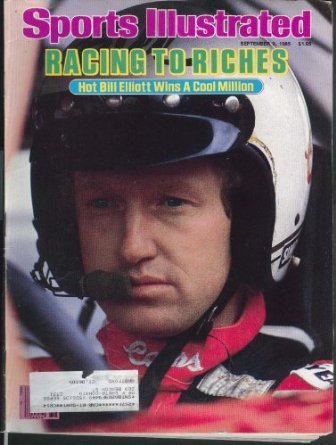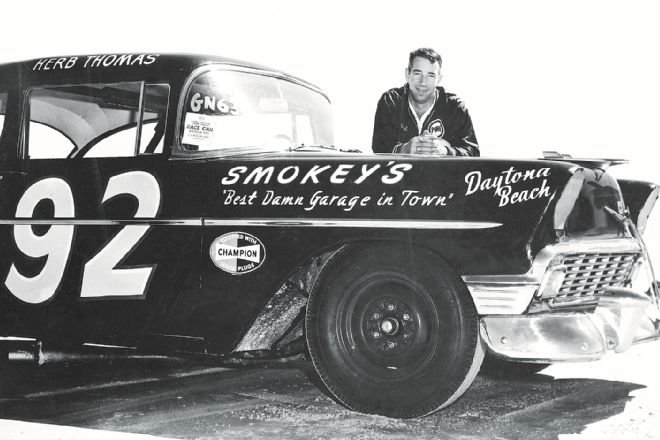
In NASCAR Cup Series competition the #9 car has started 1,721 races with 104 drivers and has 71 wins, 80 poles, 293 top 5s, and 570 top 10s.
Bill Elliott has started 446 races with 38 wins in #9 from 1976-2003.
Driving a car owned by his father, George Elliott, Elliott made his first Winston Cup Series start at Rockingham in 1976 . He qualified 34th in a field of 36 cars; Elliott only lasted 32 laps that day before the oil pump failed in his Ford Torino, earning him $640. Elliott toiled for five years in the Winston Cup Series without corporate sponsorship, and along the way showed flashes that he could compete with the established veterans of the sport. In mid-1977, Elliott bought a Mercury Montego from Bobby Allison, and the move paid off. He soon earned his first top-10 finish in the Southern 500.
In the fall of 1980, Elliott gained his first major sponsor in the form of $500 from Harry Melling of Melling Racing in the 1980 National 500 at Charlotte. Melling would extend his contract and gave the team enough sponsorship to run a 12 race schedule in 1981. Melling bought the team from Elliott’s father George on December 1, 1981. In 1983 Elliott earned his first Winston Cup win in the Winston Western 500 at Riverside in the final race of the 1983 season.
Elliott also finished second four times including the Daytona 500 on his way to a third place finish in the championship standings that season. He gained full sponsorship from Coors in 1984 to the tune of $400,000 and won three races: the Michigan 400, the Miller High Life 500, and the American 500; four poles and again finished third in the championship standings.
In 1985, Elliott earned 11 wins and 11 poles out of 28 races and also won the first Winston Million in the Southern 500 at Darlington. This earned him the nickname “Million Dollar Bill” , and “Awesome Bill From Dawsonville.” He won the Daytona 500 , the Winston 500 at Talladega and the Southern 500 to earn the Winston Million. The only major of the four he did not win was the Coca-Cola 600. This led to him becoming the second NASCAR driver to be featured on the cover of Sports Illustrated . Elliott finished second in the championship standings by 101 points, losing the Winston Cup Championship to Darrell Waltrip after a string of poor finishes in the last quarter of the season. Elliott also set an unprecedented NASCAR record of winning five consecutive pole qualifying sessions in that season.
In 1986, Elliott won both Michigan races, four poles and finished fourth in the championship standings. He also won The Winston, held at Atlanta, the only year the race was run somewhere other than Charlotte. He won six races in 1987, including his second Daytona 500, and the Talladega 500, seven poles, and finished second in the final point standings. Elliott’s most lasting accomplishment that year was setting two NASCAR qualifying records, which stand to this day. At Daytona, he set the NASCAR speed record with an average speed of 210.364 mph. He broke his own record at Talladega with an average speed of 212.809 mph; the previous record he set in 1986 was 209.383 mph. In both races, he used a Ford Thunderbird which contained an engine built by his brother Ernie. However, at Talladega, Bobby Allison was spun and went airborne into the catch fence, tearing a large section away and injuring several fans. After this incident, NASCAR mandated the use of restrictor plates at Daytona and Talladega. As a result, Elliott’s speed records will likely never be broken. In 1988 Elliott won another six races, including the Southern 500 and the Pepsi Firecracker 400, six poles, and his only Winston Cup Championship .
Following his championship season, Elliott won two poles and three races and finished sixth in the championship standings. In 1990, Elliott won one race and two poles and finished fourth in the championship standings. In the 1990 race at Atlanta, Elliott’s rear tire changer Mike Rich was killed when Ricky Rudd lost control of his car, spun, and slammed the crew member between his car and Elliott’s. This resulted in NASCAR restricting the speed of cars on pit road. The year 1991 saw Elliott’s sponsorship change to Coors Light beer and the familiar red on the car was replaced with blue. Elliott won once in the Pepsi 400 and won two poles and finished eleventh in the championship standings during his last season with the Mellings before leaving to drive for Junior Johnson in #11.
In 2000, Elliott sold his #94 team to Ray Evernham and began driving the #9 Dodge Intrepid in the following year.
The team found success in his first race in the #9 Dodge, as Elliott won the pole for the 2001 Daytona 500 and finished in the top 5, bringing home a 5th place finish. Bill finished his first season with Ray Evernham Racing with two poles and a win at the Pennzoil Freedom 400 at Homestead from the pole. This was his first win in over seven years. In 2002 he won four poles and went to victory lane twice. His wins included the Pennsylvania 500, and one week later one of the most dominant victories in the history of the Brickyard 400 at Indianapolis Motor Speedway.
His last win, in what became his final full-time season, came in 2003 at Rockingham . A week later Elliott came within a lap of winning his final race as a full-time driver in the 2003 Ford 400 at Homestead-Miami Speedway. Elliott led 189 of 267 laps and was on his way to victory, but a cut tire on the final lap gave the win to Bobby Labonte, his last win to date. He still finished the race and maintained his ninth-place position in the final points standings, his best finish since an eight-place finish in the 1997 standings. A few weeks later, Elliott announced that he was relinquishing the #9 car to Kasey Kahne and switching to a part-time schedule driving R&D cars for Evernham.
In 2018 Chase Elliott started 36 races in car #9, returning to the family number after 2 years of driving car #24 for HMS. Elliott won his Duel Qualifying race for the 2018 Daytona 500, but then struggled to post results for the first half of the season. Chevrolet’s transition to the new Camaro ZL1 seemed to be the culprit, as all of the Chevy drivers (except Larson) were not performing well.
He scored his first pole of the 2018 season at the Coke Zero Sugar 400 at Daytona. The following day, his race ended early when he was collected in the “big one” on lap 54 along with 25 other drivers after Ricky Stenhouse Jr. turned Brad Keselowski near the front of the field, resulting in a 34th-place finish for Elliott. At Watkins Glen, Elliott started third, won Stage 2, and led the final 33 laps to finally capture his first career Monster Cup Series Series victory. Chase’s win emulated his father, Bill, by finishing second eight times before winning, winning his first race on a road course, getting Hendrick Motorsports their 250th win and becoming the youngest driver to win on a road course.
Elliott secured his second career victory on October 7, 2018, holding off Denny Hamlin in overtime at Dover. With the win, Elliott secured a spot in the third round of the 2018 NASCAR Playoffs. After a final lap melee at Talladega, Elliott scored another win at Kansas later that month, holding off a hard charging Kyle Busch late in the going. He made it through the Round of 8 until he was eliminated by a late crash with Denny Hamlin and Kurt Busch at Phoenix. Elliott finished the season sixth in the points standings.
He got his first win of the 2019 season at Talladega after a crash under the white flag caused the race to end under yellow. Elliott also defeated Martin Truex Jr. at Watkins Glen for the second year in a row. Elliott breezed past the first round of the playoffs with a fourth-place finish at Las Vegas and 13th at Richmond. At the Charlotte Roval, he was leading the field on lap 65 when he locked his brakes and collided with the turn 1 tire barrier. Despite the minimal damage on his front end, Elliott took advantage of several cautions to retake the lead on lap 104 before scoring his third win of the season and his sixth career victory.
However, he finished 38th at Dover when he experienced an engine failure on the seventh lap.Elliott advanced to the Round of 8 after finishing second at Kansas, but once again failed to make the Championship 4 after crashing and finishing 39th at Phoenix.
Chase had a relatively slow start to 2020, finishing 17th in the Daytona 500 and 26th at Las Vegas. He scored 3 consecutive top-10 finishes before crashing out of the second race of the Darlington double-header while battling Kyle Busch for the lead. Chase would rebound with a 2nd place finish in the Coke 600 and a win on the Charlotte oval a few days later. Chase had a mild summer before catching fire late in the year. He followed up his win at the Bristol All-Star Race with wins at the Daytona Road Coarse and the Charlotte Roval. Facing elimination from the Playoffs, Chase would win the penultimate race of the season at Martinsville, punching his ticket into the Championship 4. Chase would dominate the season finale at Phoenix, winning his first NASCAR Cup Series Championship.
Chase won 2 races in 2021- the inaugural events at COTA and Road America, ultimately finishing 4th in the point standings.
In 2022, he notched victories at Dover, Nashville, Atlanta, Pocono, and Talladega, again finishing 4th in the points. Elliott has started 180 races in car #9 with 18 victories.
Bill Elliott was replaced by rookie driver Kasey Kahne, a successful open-wheel racer just starting to gain respect in the Busch Series, who left a development contract with Ford to sign with Evernham’s Dodge team for 2004. Kahne showed promise during his first season earning three second-place finishes through the first eleven races and five on the season, including close finishes with Matt Kenseth and Elliott Sadler. Kahne earned four pole positions and 14 top ten finishes to score a thirteenth place finish in points, winning the Rookie of the Year honors. In 2005, he won the spring Richmond race, but finished a disappointing 23rd in the final point standings. In 2006, Kahne won six races, including the prestigious Coca-Cola 600. He also made his first Chase for the Nextel Cup, finishing 8th in the standings at the end of the season. His six wins were a series high in 2006 and he also tied for the most pole awards. In 2007, it was announced that Budweiser would sponsor the #9 car beginning in 2008.
In 2009, Kahne scored his first road course victory at the Toyota/Save Mart 350 and won again at Atlanta, earning him a berth in the Chase. However, early misfortune at Loudon put the #9 team, now owned by Richard Petty Motorsports, out of contention for the championship, finishing 10th in points. 2010 would start the #9 team off on a high note by winning the 2nd Gatorade Duel in a photo finish. However, the team was plagued by inconsistency and was knocked out of Chase contention before Richmond. With a lack of results, Kahne departed the team before Martinsville and drove Red Bull Racing’s #83 Toyota. Kahne was replaced by Aric Almirola for the remaining 5 races, who had a best finish of 4th at Homestead. Kahne started the #9 car 247 times with 11 wins. Almirola made 5 starts.
Marcos Ambrose took over driving duties at the beginning of the 2011 season with Stanley Black & Decker moving over from the 19 team.
Ambrose had a break out year in the No. 9 Ford and drove to his first NASCAR Sprint Cup Series victory at Watkins Glen International in August. He finished the season with a career high, at the time, twelve top tens, and nineteenth in points. Ambrose returned in 2012, and once again won at Watkins Glen, but only had eight top tens. However, he did pick up one spot in points to eighteenth. He failed to win or finish in the top five in 2013 , but finished in the top ten on six occasions. He dropped to twenty-second in points. Despite another strong performace at Watkins Glen, in September 2014, Marcos announced he would not return to RPM for 2015, and would depart from NASCAR to return to Australia and the V8 Supercar Series for Team Penske. Shortly after beginning the Super car season, Ambrose announced that he would be stepping away from full time racing.
Roy Tyner made 224 of his 311 Cup series starts in the #9 car including the Inaugural Daytona 500 in 1959 . In addition to being a driver, Tyner eventually became a NASCAR owner. Tyner ran his own business doing auto body repair after his driving career ended. He also worked as a show car driver for Junior Johnson’s Budweiser race team. Tyner’s death was caused by a fatal gunshot to the head while he was in the show truck that was later set on fire. Local police ruled the death a suicide, but many believe foul play was involved. The case is still a mystery to this day, but has now been ruled a homicide by an unknown assailant.
Lake Speed drove the #9 car in 103 races for the Melling team between 1995-1998.
Jerry Nadeau replaced Speed and drove #9 in 38 starts from 1998-1999.
Stacy Compton drove #9 for 30 starts between the 1999-2000 seasons. In 2001 Melling gave the #9 up to Evernham Motorsports and former driver Bill Elliott. In exchange, Evernham provided technical assistance and Dodge Intrepids to the Melling car, now #92.
Tony Bettenhausen Jr. was an Indy Car driver and USAC Stock Car driver who tried his hand at NASCAR for 25 starts in 1974. Bettenhausen’s father also a racer, was killed during practice for the 1961 Indy 500.
Herb Thomas’ Hudson Hornet only wore #9 twice, winning one of those races in 1952. Also in 1952 Herb’s brother Donald Thomas won at Atlanta’s Lakewood Speedway. At age 20, he was the youngest Cup winner until Kyle Busch. Donald started the #9 Hudson Hornet 17 times.
Sam Hornish Jr. drove the #9 for RPM in 2015 in what can only be kindly described as a difficult season. Hornish managed 3 top 10s at Talladega and the 2 road course races. Hornish was replaced by Brian Scott for 2016 and the car was renumbered to #44.
Other notable names in #9
Joe Weatherly, 19 starts
Chad Little, 15 starts
Phil Parsons, 5 starts
Tim Flock, 4 starts
Tiny Lund, 5 starts
Smokey Yunick, 1 starts
Cale Yarborough, 1 start




















